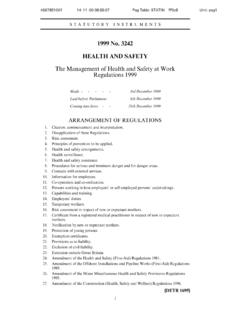Transcription of Safety Data Sheet - Cambridge-Lee Industries
1 Rev. Date: Page 1 of 7 Safety data Sheet MANUFACTURER 24-Hour Emergency Telephone Number Cambridge Lee Industries LLC 86 Tube Drive Reading, PA 19605 Gregory F. Creswell, CSP Director, EHS Cambridge Lee Industries LLC (484) 637-6369 - mobile Telephone Number: (610) 926-4141 NOTE: Emergency numbers should be used only in the event of chemical emergencies involving spills, leaks, fire, exposure, or in the event of an accident involving chemicals. All non-emergency questions should be directed to the EHS Department at 610-926-7368 or email to Date Issued: 19 June 2015 SDS Prepared By: Gregory F.
2 Creswell, CSP Director, EHS Section I PRODUCT IDENTIFICATION CHEMICAL NAME: CDA 147 Sulfur Copper CHEMICAL FAMILY: Metals TRADE NAMES: Copper tubing (all sizes and wall thicknesses) FORMULA: The hazardous constituents are given below for each alloy. Section II Hazard Identification Classification or the substance or mixture: Not classified under any GHS hazard class Label elements: Not applicable (not classified) Other hazards: No know health hazards from copper tube in solid form. Under normal conditions of use, the solid article does not release more than very small quantities of hazardous substances and does not pose a physical hazard or health risk to employees.
3 Metallic fumes may be released from heating copper tube above its melting point. May pose an inhalation hazard if exposed above the recommended limits. May pose an inhalation hazard if exposed to metal dust from machining operations such as grinding or cutting such as filings or dust. Metallic copper may be moderately irritating to the gastrointestinal tract if ingested which is not a primary route of exposure. Other hazard classifications: As sold, the solid article is not considered hazardous by the OSHA Hazard Communication Standard (29 CFR ) Safety data Sheet Rev.
4 Date: Page 2 of 7 Section III Hazard Identification HAZARDOUS CONSTITUENTS FOR WHICH PELs or TLVs EXIST ALLOYS PERCENT CAS NUMBER EXPOSURE LIMITS (mg/m3) OSHA1 PEL ACGIH2 TLV Element PEL/ TLV Established for Copper Dust 7440-50-8 1 mg/m3 1 mg/m3 Fume 7440-50-8 mg/m3 mg/m3 SUMMARY: These products may contain small amounts (<1%) of various chemicals in addition to those listed. These small quantities are frequently referred to as trace or residual elements that generally originate in the raw materials used.
5 NOTE: No permissible exposure limits (PELs) or threshold limit values (TLVs) exist for these specific alloys. Values shown are applicable to component elements. Various combinations of the above components may appear in grades supplied. More specific information on a particular grade may be obtained by contacting Cambridge Lee Industries LLC. 1 OSHA Permissible Exposure Limits (PELs) are 8-hour Time-Weighted Average (TWA) concentrations unless otherwise noted. 2 Threshold Limit Values (TLV) established by the American Conference of Governmental Industrial Hygienists (ACGIH) are 8-hour TWA concentrations unless otherwise noted.
6 A Short Term Exposure Limit (STEL) is a 15-minute TWA exposure that should not be exceeded at any time during a workday, even if the 8-hour TWA is within the TLV-TWA. Emergency Overview Cambridge Lee Industries LLC considers this product in the solid form to be nonhazardous. However, operations such as abrading, burning, welding, sawing, brazing, grinding, cutting, polishing, and machining that results in the creation of dust or elevated temperatures may cause eye, skin, and respiratory tract irritation. Safety data Sheet Rev. Date: Page 3 of 7 Section IV first Aid Measures Primary entry routes Inhalation: If symptoms are experienced, remove source of contamination or move person to fresh air.
7 Get medical advice / attention if you are concerned with potential overexposure. Ingestion: Call a Poison Control Center or seek medical treatment. Skin Contact: Wash with plenty of water. If skin irritation occurs, seek medical treatment. Eye Contact: Flush with water for 15 minutes holding the eyelid(s) open. DO NOT rub eye(s). If irritation persists, seek medical treatment. DO NOT attempt to manually remove any particles stuck in the eye(s). Effects of overexposure Acute Inhalation: Possible metal fume fever. Symptoms are chills, fever, aching muscles, dry mouth and throat, headache, nausea, vomiting or diarrhea.
8 Onset may be delayed several hours. Ingestion: Swallowing metallic dust may case gastrointestinal discomfort with nausea, vomiting and diarrhea. Skin Contact: Overexposure to this material in the form of metal fragments or dust may cause mechanical irritation or dermatitis. Contact with the heated product will cause thermal burns. Eye Contact: Overexposure to this material in the form of metal fragments may cause mechanical irritation as a foreign object. Fumes may be irritating to the eyes. Repeated occupational exposures to dust and fumes may cause conjunctivitis. Effects of overexposure Chronic No long term effects known.
9 Carcinogenic references None known Medical conditions aggravated by exposure Individuals with Wilson s disease , a rare condition that interferes with the body s ability to eliminate copper, should consult a physician before exposures to copper dusts and fumes. Preexisting pulmonary and skin conditions may be aggravated by prolonged exposure to dust and chips. Section V Firefighting Measures Extinguishing media Use water or other extinguishing media appropriate for the surrounding fire. Do not apply water to hot or molten metal. Explosion hazard Fine copper powder is a moderate fire hazard.
10 In the presence of halogenates, copper powder may be explosive with heat, percussion or friction. Special hazards Not flammable. Solid forms of copper such as tubing, cathode or billets will not burn or support combustion or decompose to toxic gases. Advice for firefighters As for any fire, evacuate the area and fight the fire from a safe distance. Wear necessary protective equipment as with any other firefighting activity. Safety data Sheet Rev. Date: Page 4 of 7 Section VI Accidental Release Measures Spills or leaks Scoop or shovel spilled material into an appropriate waste container for recycling or disposal.









